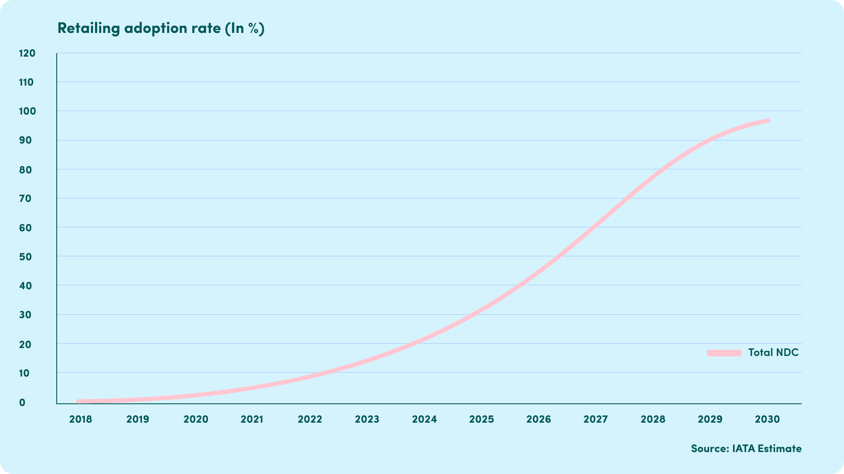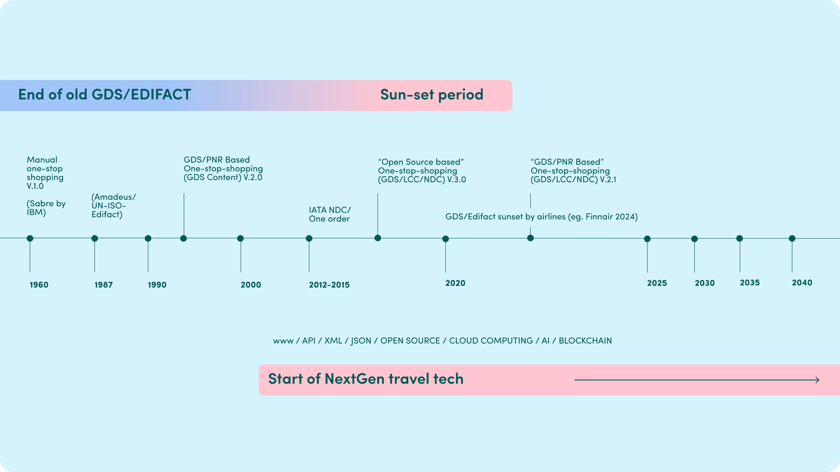What’s the deal with GDS and NDC?
A notable change in the travel tech landscape is the industry-wide shift towards New Distribution Capability (NDC). The move from GDS to NDC marks a major milestone in travel tech, but it also highlights a key limitation of legacy systems. Platforms locked into GDS-only models cannot access the full benefits of NDC, leaving businesses with fewer options and less flexibility.
What is NDC?
NDC (New Distribution Capability) is an advanced technology standard developed by the International Air Transport Association (IATA). This new XML-based communications standard was developed to help airlines bring richer content and ancillaries directly to online travel agencies (OTAs), corporate travel management companies (TMCs), and other flight resellers through a set of travel APIs (Application Programming Interfaces). NDC also improves how airlines and travel agents exchange information, and is accessible to all third parties, intermediaries, and technology providers.
Essentially, NDC empowers airlines to share more detailed and customized product offerings directly to travel agencies and booking systems, in real time. This includes not just basic flight data but also ancillary services like seat upgrades, additional baggage, flexible cancellation policies, loyalty programs, and special deals for frequent travelers.
The shift from GDS to NDC
The traditional GDS system was designed in the 1960s to handle flight inventory distribution across airlines, travel agents, and booking platforms. It was revolutionary at the time but now faces limitations, especially in terms of its flexibility and ability to adapt to modern traveler expectations. GDSs have become somewhat rigid and offer only a narrow, standardized set of products, primarily focused on flight booking. For example, they often do not include more complex travel packages (like customized itineraries) or offer access to low-cost carriers and smaller hotel chains.
NDC changes this by allowing airlines to bypass GDSs entirely and distribute their content directly, with much richer and more personalized options. This includes special fare bundles, detailed flight info, flexible options for baggage, and more.
So what's the status with NDC now?
Since IATA launched NDC in 2012, adoption has progressed slowly but steadily. As of 2024, a significant number of major airlines have implemented NDC to varying degrees, with some fully embracing the technology while others are in different stages of adoption. The trend shows an acceleration in NDC implementation, particularly among larger carriers and in regions with more developed aviation markets.
The chart below illustrates projected growth in NDC volume over the coming years, according to IATA. Naturally, this trajectory will be shaped by a range of factors that can influence adoption. (Source: IATA)

Even though we've still not reached IATA's 2030 goal of 100% adoption, the growing emphasis on New Distribution Capability (NDC) and the presence of clear NDC strategies among the largest IATA member airlines are significant developments. These major carriers account for approximately 85-90% of the revenue generated by the roughly 330 IATA member airlines. In contrast, many smaller airlines lack the resources to develop their own NDC platforms and depend on third-party providers, such as Amadeus Altea, for assistance.
According to recent industry reports, approximately 60% of IATA member airlines have achieved some level of NDC certification, with about 30% actively using NDC for a portion of their distribution. For example, Air France-KLM continues to strengthen their NDC offerings in 2025, with 88% of tickets now being issued through NDC. Similarly, the Lufthansa Group has also embraced NDC, with a focus on providing richer content and better customer experiences through this modern distribution channel.
Implementing NDC is much like building an entirely new infrastructure for the travel industry: it requires rethinking long-established distribution models and replacing legacy connections with modern technology. This shift calls for extensive coordination between airlines, agencies, technology partners, and regulators to ensure systems communicate effectively, data security is maintained, and the traveler experience is seamless. While the goal set by IATA is for all airlines to be NDC-ready by 2030, the scale and complexity of this transformation means that true industry-wide adoption takes time and cooperation across all stakeholders -including legacy systems.
The timeline of the changes happening to the travel industry - specifically airline ticket distribution) can be seen in the illustration below. (Source: Goodwings)

The benefits of NDC
- Richer Content and competitive pricing
NDC allows airlines to display richer, more detailed offerings—including images, videos, and multimedia—giving travelers a clearer view of their options. NDC also enables airlines to display a wider range of options and real-time fare information, making it easier for travel bookers to find the best deals.
- Upgrading is integrated into the booking flow
Extra ancillary services like seat upgrades, baggage, or lounge access can be offered as part of the booking flow, making customization and add-ons easy and improving the overall booking experience.
- Personalization
Airlines can customize deals based on individual traveler profiles, preferences, and loyalty status, making each trip more relevant.
- Real-time updates and improved transparency
With NDC, airlines can update flight availability, prices, and ancillary services in real time, ensuring travelers and bookers always have up-to-date information. The detailed breakdowns of flight options also enable travel managers to choose the options that align with traveler preferences and company policies.
- Avoiding GDS Surcharges
By bypassing traditional GDS channels, travel managers avoid additional booking surcharges, resulting in cost savings and greater flexibility over travel arrangements.
|

%201.png?width=340&height=310&name=AdobeStock_667647909-1%20(1)%201.png)


